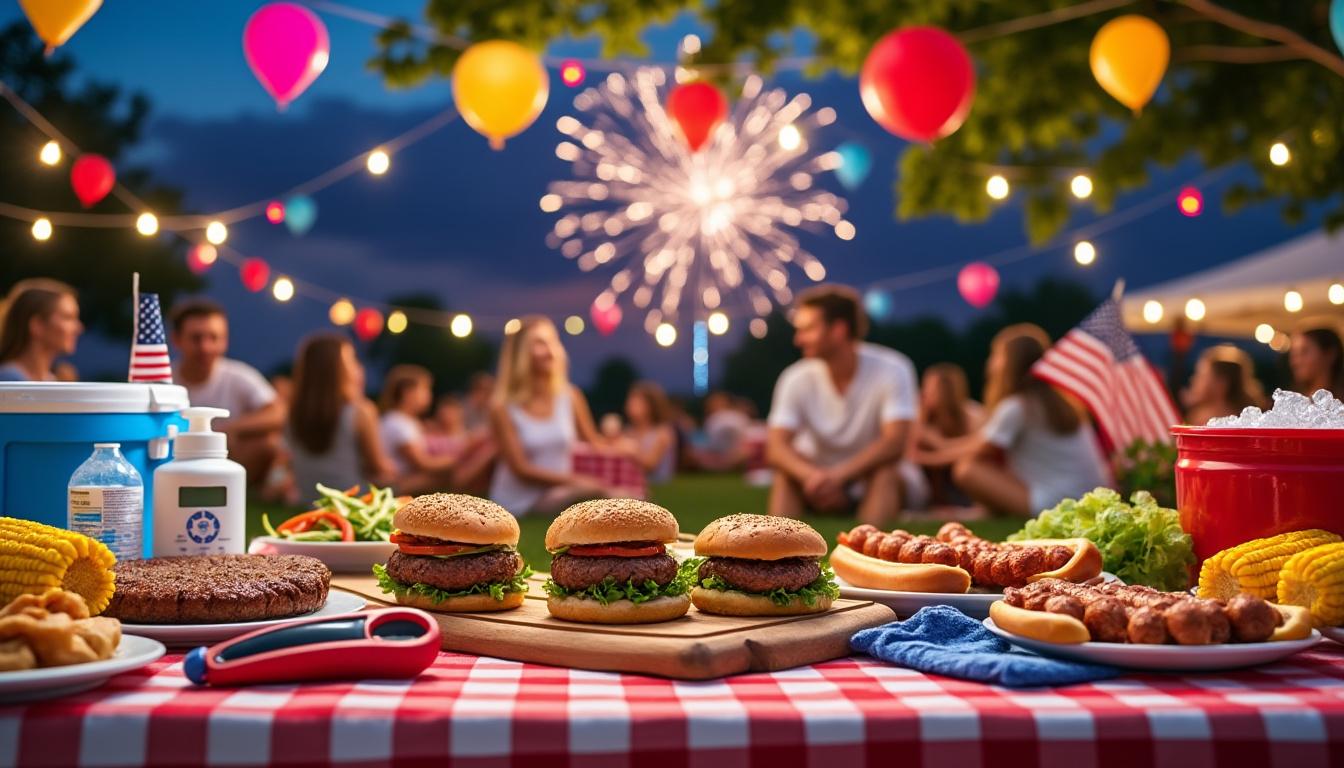The 4th of July is synonymous with vibrant fireworks, sizzling grills, and joyous gatherings. Yet, as Americans gear up to celebrate one of the nation’s most cherished holidays, ensuring food safety remains crucial. With outdoor cookouts and potlucks becoming the centerpiece of festivities, the risk of foodborne illnesses surges, threatening not only health but also the spirit of celebration. Prioritizing food safety through well-informed practices can transform your Independence Day event into a memorable and trouble-free experience. From proper grilling techniques to safe storage and guest considerations, a comprehensive approach is essential to keep the holiday safe and enjoyable. This article delves into essential guidelines that blend safety with flavor, highlighting how to CookSmart and ChillOutSafety for a truly PartySafeEats occasion.
Prioritizing Food Safety First: Preparing and Handling Your 4th of July Cookout
Successful festivities start well before the grill is fired up. FoodSafetyFirst begins with meticulous preparation and handling of ingredients. This approach not only minimizes contamination risks but also maintains the nutritional quality and taste integrity of your dishes.
Proper sourcing of meats, produce, and ready-to-eat foods is foundational. Purchasing from reputable vendors ensures that items are fresh and have been stored under optimal conditions. For example, when selecting meats for your grill, look for clear expiration dates and avoid packages that show any signs of leakage or discoloration. Fresh fruits and vegetables should be crisp and free from bruises, cut marks, or mold.
Once home, correct storage is indispensable. Perishable foods must be refrigerated promptly at temperatures below 40°F (4°C). Thawing frozen items also demands caution; the safest methods include thawing in the refrigerator, using cold water changed every 30 minutes, or microwave thawing — never at room temperature. Thawing at room temperature invites bacterial growth, leading to potential foodborne illnesses. These guidelines uphold the ethos of CleanCook, reducing microbial hazards and maintaining freshness.
Marinating meats requires special attention. Always marinate in the refrigerator rather than on the countertop. If planning to use leftover marinade as a sauce, bring it to a rolling boil to kill pathogens before serving. This precaution protects guests from common bacterial threats found in raw meat juices.
- Check expiration dates and packaging integrity
- Refrigerate perishables promptly
- Choose safe thawing methods: fridge, cold water, microwave
- Marinate only under refrigeration and boil leftover marinade
- Practice CleanCook by washing hands and surfaces regularly
| Food Item | Safe Thawing Method | Maximum Thaw Time (approx.) | Storage Temperature |
|---|---|---|---|
| Chicken | Refrigerator | 24-48 hours | < 40°F (4°C) |
| Beef | Cold Water (in sealed bag) | 2-3 hours (change water every 30 min) | < 40°F (4°C) |
| Seafood | Microwave | Immediate cooking post-thaw | < 40°F (4°C) |
Observing these preparatory steps aligns with the principles detailed in safe and delicious holiday cookout practices, ensuring your 4th of July feast starts on a hygienic note. Adopting this mindset saves celebrants from unfortunate foodborne outbreaks that could potentially disrupt their gatherings and cause significant health risks.
Mastering SafeGrilling Techniques to Eliminate Foodborne Risks
Effective grilling is at the heart of any 4th of July celebration. However, improper grilling can become a vector for foodborne illnesses, especially when meats are undercooked or cross-contamination occurs.
SafeGrilling involves monitoring internal temperatures closely. Use a calibrated food thermometer to ensure meats reach USDA recommended temperatures: 165°F (74°C) for poultry, 160°F (71°C) for ground meats, and 145°F (63°C) followed by a 3-minute rest for whole muscle cuts like steaks. Undercooked meats pose significant health threats from bacteria such as Salmonella and E. coli.
Cross-contamination frequently happens through the misuse of utensils or plates. Designate separate plates and tongs for raw and cooked foods. Avoid placing cooked items back on surfaces that held raw meat unless thoroughly sanitized. Consider implementing the MultiGrillGuardian approach — using multiple grilling zones or separate grills to keep different proteins apart, especially if guests have allergies or dietary concerns.
When serving, keep hot foods hot (above 140°F / 60°C) and cold foods cold (below 40°F / 4°C) to prevent pathogen growth. If food sits out for more than 2 hours — or 1 hour in temperatures above 90°F (32°C) — discard the leftovers to maintain HolidayHealthCheck standards and prevent illnesses.
- Measure internal meat temperatures accurately
- Use separate utensils and plates for raw and cooked foods
- Keep hot foods hot and cold foods cold during serving
- Avoid cross-contamination by using MultiGrillGuardian methods
- Discard foods left out beyond safe time limits
| Meat Type | Safe Internal Temperature (°F) | Safe Internal Temperature (°C) | Rest Time |
|---|---|---|---|
| Poultry (whole or ground) | 165 | 74 | None |
| Ground beef, pork, lamb | 160 | 71 | None |
| Steaks, chops, roasts | 145 | 63 | 3 minutes |
For additional expert grilling insights tailored for Independence Day, consult safe grilling chicken and steak guidelines. Employing these methods translates into a safer, more flavorful grilling experience that your guests will appreciate and remember.
When grilling outdoors, take weather and environmental conditions into account. High temperatures or direct sunlight can accelerate food spoilage if safety guidelines are overlooked. Using shaded or cooler spots to position food stations, along with regular hydration for guests, enhances overall comfort and safety during the event.
Chilling Out Safeguards: Proper Cooling and Storage Techniques for Leftovers
Post-celebration food safety is as significant as prep and cooking. ChillOutSafety entails quickly cooling foods and storing leftovers properly to suppress bacterial growth and prolong freshness, all while contributing to waste reduction, a focus echoed in store leftovers avoid waste efforts.
Leftovers should be refrigerated within two hours of cooking, or within one hour if outdoor temperatures exceed 90°F (32°C). Foods must be stored in shallow, airtight containers to allow rapid, even cooling. Avoid overfilling containers, which can trap heat and create microbial safe havens.
Designate clear labeling on leftover containers with the date and contents to maintain an efficient consumption schedule and prevent accidental consumption of spoiled items. Typically, leftovers remain safe for up to 3-4 days refrigerated or up to 3-4 months when frozen. Always reheat leftovers to an internal temperature of 165°F (74°C) before consumption.
- Refrigerate leftovers promptly within 2 hours
- Use shallow, airtight containers for storage
- Label leftovers with date and content
- Follow recommended consumption timelines for leftovers
- Reheat to 165°F (74°C) before eating
| Storage Method | Recommended Temperature | Safe Holding Time | Tips |
|---|---|---|---|
| Refrigerator | < 40°F (4°C) | 3-4 days | Store in shallow containers, do not overload fridge |
| Freezer | < 0°F (-18°C) | 3-4 months | Use freezer-safe containers or bags |
Integrating these ChillOutSafety practices enhances not only food quality but also conservation efforts, complementing strategies seen in efficient holiday cookout planning. For more insights on budgeting and healthy eating while managing food safely, visit eat healthy on a tight budget.
FireworksFoodCare and Its Role in a Holistic 4th of July PartySafeEats Celebration
Fireworks are an iconic part of 4th of July celebrations but ensuring FireworksFoodCare integrates with food safety protocols enhances overall event wellbeing. Fireworks and cooking often happen in shared spaces, increasing risks like accidental burns or contamination.
Maintain a safe distance between fireworks setups and food preparation or dining areas. Designating separate zones helps minimize disruptive incidents and prevents debris contamination on food surfaces. Handling fireworks safely also reduces emergency occurrences that could overshadow the holiday spirit.
During fireworks displays, avoid leaving food uncovered outdoors to protect against insects and airborne debris. Using mesh food covers or enclosed serving trays are practical options to keep insects at bay while allowing guests to enjoy TastAndSafety without compromise.
- Separate fireworks and food areas clearly
- Use food covers during outdoor fireworks displays
- Keep fire extinguishers and water nearby for emergencies
- Supervise children closely around both grills and fireworks
- Adopt FireworksFoodCare to blend safety and celebration
| Precaution | Recommended Action | Safety Benefit |
|---|---|---|
| Food contamination risk | Cover all food when fireworks are active | Prevent dirt, residue, and insects from contaminating food |
| Fire hazard | Keep fire extinguishers, buckets of water nearby | Quick response to accidental fires |
| Child safety | Maintain adult supervision around grills and fireworks | Reduce burn and injury risks |
Following these FireworksFoodCare guidelines guarantees that the celebration remains joyful and safe. Review additional safety tips on managing fireworks from recent advisories and ensure compliance with local regulations for a worry-free evening.
Ensuring PartySafeEats for Diverse Group Needs and Sustaining HolidayHealthCheck
The 4th of July brings together diverse groups, including children, elderly individuals, and guests with dietary restrictions. Ensuring PartySafeEats means accommodating these needs while upholding holistic HolidayHealthCheck standards.
Children are particularly vulnerable to foodborne illnesses due to developing immune systems. Special care must be taken with dairy products, eggs, and prepared salads. Avoid using raw eggs in homemade mayonnaise or dressings to protect younger guests.
Elderly guests often face weakened immunity, requiring foods to be cooked thoroughly and held at proper temperatures to prevent infections. Providing a range of healthy, seasonal options supports wellness and enjoyment simultaneously. Incorporating fruits and vegetables fresh from the garden, coupled with recommendations on watering techniques for gardens, ensures that ingredients are at their peak nutritional value.
For those managing allergies or specific diets, clearly label dishes and avoid cross-contact during preparation and serving. Adoption of labeling systems or designated allergen-free zones enhances guest safety and satisfaction.
- Cater to vulnerable groups with carefully prepared foods
- Provide diverse, healthy options from fresh, seasonal produce
- Clearly label allergen-containing dishes
- Use designated serving utensils to prevent cross-contact
- Monitor and maintain HolidayHealthCheck throughout the event
| Guest Group | Food Safety Considerations | Recommended Practices |
|---|---|---|
| Children | Avoid raw eggs, thoroughly cook meats | Use pasteurized eggs, monitor serving temps |
| Elderly | Weakened immunity requires safe holding temperatures | Serve hot foods promptly, avoid buffet time extremes |
| Allergy Sensitive | Risk of cross-contact with allergens | Label foods, use separate utensils |
Integrating PartySafeEats with HolidayHealthCheck principles creates an inclusive environment where health and enjoyment coexist seamlessly. For practical kids’ nutrition and lunchbox ideas that support safe eating, refer to lunchbox ideas for kids.
Frequently Asked Questions About 4th of July Food Safety
- What is the safest way to thaw meat for grilling?
The safest methods include thawing in the refrigerator, under cold running water changed every 30 minutes, or using a microwave. Thawing at room temperature is unsafe and encourages bacterial growth. - How long can cooked food safely remain out during outdoor parties?
Cooked food should not be left out for more than 2 hours, or 1 hour if the outdoor temperature is above 90°F (32°C). Beyond this, bacteria can multiply to unsafe levels. - How can I prevent cross-contamination while grilling?
Use separate utensils and plates for raw and cooked foods, avoid reusing marinades without boiling, and consider separate grilling zones to segregate different types of food. - How should leftovers be stored and reheated?
Store leftovers in shallow, airtight containers and refrigerate within 2 hours of cooking. Reheat leftovers to an internal temperature of 165°F (74°C) before consuming. - What precautions should be taken to keep children safe around grills and fireworks?
Maintain constant adult supervision, establish clear safety zones, and educate children on the dangers of hot surfaces and explosives during celebrations.

